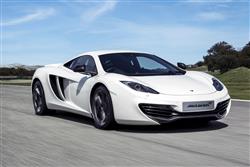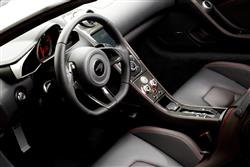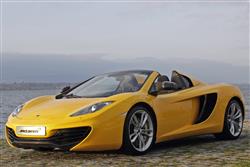FAST FEUD (some text hidden) --NONE--
BY ANDY ENRIGHT
Introductionword count: 95
Prior to the MP12-C, McLaren had only built one road car by themselves and it's a car that many reckoned to be the greatest of all time, the iconic F1. How do you even begin to follow that? The answer was to do something different. Instead of building an F1 replacement, McLaren lowered its sights a little and instead targeted the supercar heartland occupied by the Ferrari 430 and the Lamborghini Gallardo. The MP4-12C is undoubtedly the most usable and technically intriguing of this exotic trio, but does it make sense as a used purchase?
Modelsword count: 9
(2 dr coupe, 2 dr targa 3.8 litre petrol)
Historyword count: 594
McLaren is a company that tends not to do things by half measures. When it unveiled the F1 in 1993, it created a market niche of its own. The previous definition of 'supercar' seemed wholly inadequate for this no-holds barred engineering exercise, and where the F1 led, cars like the Bugatti Veyron, Koenigsegg Agera, and Pagani Zonda followed. An ill-starred dalliance with Mercedes-Benz produced the unlovely SLR, a car neither party seemed happy with. Still, the SLR project spurred both companies to really pull out all the stops to show that they weren't the weak half of the partnership. Mercedes' go-faster division, AMG, developed the lovely SLS gullwing and McLaren built the car we look at here, the MP4-12C. The name takes a bit of getting used to. It's not exactly charismatic. In fact it's a model designation you'd probably think was more suited to a wireless router than a £200,000+ supercar. As with all things McLaren, there's a certain logic about it, 'MP4' standing for McLaren Project 4, resulting from the merger of chairman Ron Dennis' Project 4 organisation with McLaren. The '12' refers to McLaren's internal Vehicle Performance Index through which it rates key performance criteria both for competitors and for its own cars. The criteria combine power, weight, emissions, and aerodynamic efficiency. The 'C' refers to Carbon, highlighting the application of carbon fibre technology to the future range of McLaren sports cars. It was logical, yes, but the public hated it and by the end of 2012, the name was officially shorthanded to 12C. The open-top version that was introduced at the same time was thus dubbed the 12C Spider. There was a strong suspicion that the 12C had been rushed into production slightly early, with early cars suffering IRIS infotainment systems that weren't fully functional. McLaren also responded to customer criticism that the car was too quiet, and in 2012 introduced a series of upgrades. These included a 25bhp increase from its twin-turbo 3.8-litre V8 to 616bhp, a recalibrated seven-speed twin-clutch gearbox and a retuned 'Intake Sound Generator' (ISG) system that creates greater “aural drama” in the cabin. McLaren maintained close ties with existing owners over the IRIS issue and many of the upgrades were also fitted retrospectively to existing cars at no cost. Other changes introduced included headlights that switched on automatically in the rain, a beefed up climate control system, a memory function for the seats, a stereo upgrade, new paint finishes, alloy wheels designs and interior trim. A lifter kit that raised ground clearance by 40mm at the front and 25mm at the rear at speeds of up to 37mph was also introduced but couldn't be retrofitted to existing cars and nor could the new door opening system that featured a button rather than the previous touch sensor. In 2014 McLaren launched the 650S, a comprehensively upgraded version of the 12C with more power, revised suspension and a P1-style front end amongst a whole raft of changes. Priced within £20k of the 12C, the 650S effectively killed UK 12C sales dead, the previous car only going to a handful of export markets. From summer 2014, McLaren offered existing 12C owners new software for the active aerodynamics which allowed the airbrake to deploy during a throttle lift or when cresting a rise. It can also drop when driving at speed in a straight line, much like a Formula 1 drag reduction system. There was also an upgrade for the Android system. The fitment of a reversing camera and DAB digital radio could also be added as cost options.
What You Getword count: 702
McLaren's record in Formula 1 suggests it knows a thing or two about aerodynamics and lightweight design. As you'd expect, it's knowledge used to full effect on this 12C. Weight has been meticulously purged from this car at every stage of its design and development, with the aim of maximising performance and handling. Just like a racing car, this machine is built around a one-piece custom-moulded carbon fibre chassis that McLaren calls the MonoCell. Weighing just 75kgs, it's 25% stiffer than an equivalent all-metal structure and 25% lighter than the kind of comparable aluminium chassis you'd find in a rival Ferrari 458. It's also stronger and safer in a crash, acting as a safety survival cell, just as it does in a Formula 1 car. But let's start with what you can see, a car that's as short, narrow and low as ex-Ferrari stylist Frank Stephenson felt able to get away with. Pinching every inch to reduce the width has particular advantages when it comes to threading this car through tight city streets and this, along with the large, deep windscreen, plays its part in making this car a great deal more everyday-usable than you might expect it to be. Does the overall shape have the same visual exclusivity as its main Italian competitor? Perhaps not, but it's still a very beautiful thing indeed and especially attractive in open-topped Spider form. I love the detailing: the neatly integrated daytime running lights that when lit, replicate McLaren's Kiwi badge. And the unique profile that sees dominant side air inlets divided by dramatic turning vanes that help direct cooling air over the side radiators. At the rear, where the twin turbo V8 engine is visible through a thin glass cover, the exhaust tailpipes exit high in the centre of the car, flanked by LED tail light clusters hidden by horizontal black bars. All of these are delicious details but the feature you'll get most familiar with is this one, the dihedral scissor door arrangement. You fish beneath the panel here for the opening button then move the door forward and upwards to open. McLaren says the arrangement makes getting in and out of the car easier but I'd also point out than when open, these doors increase the car's width by a couple of feet on each side. In other words, you might want to choose a bay at the empty far end of the car park to be on the safe side. Getting inside means hurdling a wide sill of the kind you'd also have to negotiate in a Mercedes SLS but at least, unlike the gullwing Merc, it's easy to close the door again from a seated position. Once inside, you're faced with a very workmanlike space entirely designed around a driving position that's been brought closer to the centre of the car, necessitating a sat nav and audio system 7” telematics touchscreen that, rather unusually, has been turned up on its side into a 'portrait' mode that McLaren reckons is easier to read. Ahead of you sits a squared-off oval steering wheel with a thin-rim modelled precisely on that used in the company's Formula 1 cars, though fortunately, it hasn't been infested with all the knobs and buttons you'd find in one of those. Minimalism is also the order of the day on the dash, dominated by a single centre red-needled rev counter dial. Here is a place to do business. A place of control aided by a decently-sized pedal box (so you don't have to wear racing boots to properly flick between the pedals) and all round standards of visibility that are anything but supercar-like. Even rear vision isn't too bad. In the open-topped Spider model of course, it's particularly nice if you're able to remove the two-piece metal-folding roof that opens or closes in 17s at speeds of up to 19mph. This folds into a small space under the tonneau cover which, when the roof is raised, doubles as extra storage. Storage you may well need given that there's only 144-litres of trunk room in the space provided beneath the bonnet. Still, that's the most on offer in this segment and is enough for a couple of small suitcases.
To see the full road test text contact us on 0330 0020 227
Pictures (high res disabled)
.jpg)
.jpg)
|
.jpg)
|
.jpg)
| |||

|
.jpg)
|

| |||

|
Scoring (subset of scores)
Category: Sporting Cars
| Performance | |
| Handling | |
| Comfort | |
| Space | |
| Styling, Build, Value, Equipment, Depreciation, Handling, Insurance and Total scores are available with our full data feed. | |



